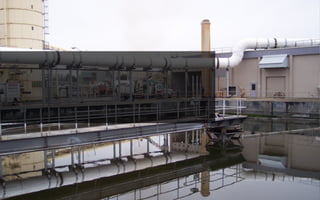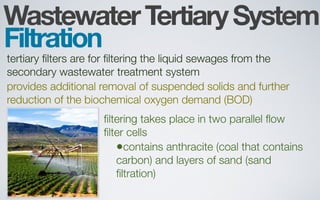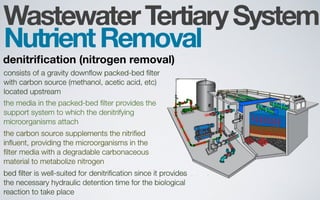Editor's Notes
- \n
- \n
- \n
- \n
- \n
- \n
- \n
- \n
- \n
- \n
- \n
- \n
- \n
- \n
- \n
- \n
- \n
- \n
- \n
- \n
- \n
- \n
- \nPACKAGE TERTIARY FILTER SYSTEMS FOR WASTEWATER TREATMENT\nPollution Control Systems tertiary filters are for filtering the liquid effluent from a secondary wastewater treatment system. The tertiary filter system provides for additional removal of suspended solids from the secondary effluent and a further reduction of the biochemical oxygen demand (BOD).  The filtering takes place in two parallel flow filter cells, each containing filter media consisting of a layer of anthracite and a layer of sand through which the liquid flows.\n
- \nPACKAGE TERTIARY FILTER SYSTEMS FOR WASTEWATER TREATMENT\nPollution Control Systems tertiary filters are for filtering the liquid effluent from a secondary wastewater treatment system. The tertiary filter system provides for additional removal of suspended solids from the secondary effluent and a further reduction of the biochemical oxygen demand (BOD).  The filtering takes place in two parallel flow filter cells, each containing filter media consisting of a layer of anthracite and a layer of sand through which the liquid flows.\n
- \nPACKAGE TERTIARY FILTER SYSTEMS FOR WASTEWATER TREATMENT\nPollution Control Systems tertiary filters are for filtering the liquid effluent from a secondary wastewater treatment system. The tertiary filter system provides for additional removal of suspended solids from the secondary effluent and a further reduction of the biochemical oxygen demand (BOD).  The filtering takes place in two parallel flow filter cells, each containing filter media consisting of a layer of anthracite and a layer of sand through which the liquid flows.\n
- \nPACKAGE TERTIARY FILTER SYSTEMS FOR WASTEWATER TREATMENT\nPollution Control Systems tertiary filters are for filtering the liquid effluent from a secondary wastewater treatment system. The tertiary filter system provides for additional removal of suspended solids from the secondary effluent and a further reduction of the biochemical oxygen demand (BOD).  The filtering takes place in two parallel flow filter cells, each containing filter media consisting of a layer of anthracite and a layer of sand through which the liquid flows.\n
- \nPACKAGE TERTIARY FILTER SYSTEMS FOR WASTEWATER TREATMENT\nPollution Control Systems tertiary filters are for filtering the liquid effluent from a secondary wastewater treatment system. The tertiary filter system provides for additional removal of suspended solids from the secondary effluent and a further reduction of the biochemical oxygen demand (BOD).  The filtering takes place in two parallel flow filter cells, each containing filter media consisting of a layer of anthracite and a layer of sand through which the liquid flows.\n
- \n
- \n
- \n
- \n
- \n
- \n
- \n
- \n
- \n
- \n
- \n
- \n
- \n
- \n
- \n
- \n
- \n
- \n
- \nThe packed-bed filter is well-suited for denitrification because it provides the necessary hydraulic detention time for the biological reaction to take place. It also filters out solids, eliminating the need for downstream filtration or clarification units required of other denitrification systems.\n
- \nThe packed-bed filter is well-suited for denitrification because it provides the necessary hydraulic detention time for the biological reaction to take place. It also filters out solids, eliminating the need for downstream filtration or clarification units required of other denitrification systems.\n
- \nThe packed-bed filter is well-suited for denitrification because it provides the necessary hydraulic detention time for the biological reaction to take place. It also filters out solids, eliminating the need for downstream filtration or clarification units required of other denitrification systems.\n
- \nThe packed-bed filter is well-suited for denitrification because it provides the necessary hydraulic detention time for the biological reaction to take place. It also filters out solids, eliminating the need for downstream filtration or clarification units required of other denitrification systems.\n
- \n
- \n
- \n
- \n
- \n
- \n
- Lagooning provides settlement and further biological improvement through storage in large man-made ponds or lagoons. These lagoons are highly aerobic and colonization by native macrophytes, especially reeds, is often encouraged. Small filter feeding invertebrates such as Daphnia and species of Rotifera greatly assist in treatment by removing fine particulates.\n[edit]\n\n
- Lagooning provides settlement and further biological improvement through storage in large man-made ponds or lagoons. These lagoons are highly aerobic and colonization by native macrophytes, especially reeds, is often encouraged. Small filter feeding invertebrates such as Daphnia and species of Rotifera greatly assist in treatment by removing fine particulates.\n[edit]\n\n
- Lagooning provides settlement and further biological improvement through storage in large man-made ponds or lagoons. These lagoons are highly aerobic and colonization by native macrophytes, especially reeds, is often encouraged. Small filter feeding invertebrates such as Daphnia and species of Rotifera greatly assist in treatment by removing fine particulates.\n[edit]\n\n
- Improves disinfection efficacy\nReduces environmental, health and safety risks\nEliminates formation of disinfection by-products\nDoes not alter the aesthetic qualities of the water\nEliminates any concerns with "over dosing"\n
- Improves disinfection efficacy\nReduces environmental, health and safety risks\nEliminates formation of disinfection by-products\nDoes not alter the aesthetic qualities of the water\nEliminates any concerns with "over dosing"\n
- Improves disinfection efficacy\nReduces environmental, health and safety risks\nEliminates formation of disinfection by-products\nDoes not alter the aesthetic qualities of the water\nEliminates any concerns with "over dosing"\n
- Improves disinfection efficacy\nReduces environmental, health and safety risks\nEliminates formation of disinfection by-products\nDoes not alter the aesthetic qualities of the water\nEliminates any concerns with "over dosing"\n
- Improves disinfection efficacy\nReduces environmental, health and safety risks\nEliminates formation of disinfection by-products\nDoes not alter the aesthetic qualities of the water\nEliminates any concerns with "over dosing"\n
- Improves disinfection efficacy\nReduces environmental, health and safety risks\nEliminates formation of disinfection by-products\nDoes not alter the aesthetic qualities of the water\nEliminates any concerns with "over dosing"\n
- Improves disinfection efficacy\nReduces environmental, health and safety risks\nEliminates formation of disinfection by-products\nDoes not alter the aesthetic qualities of the water\nEliminates any concerns with "over dosing"\n
- Improves disinfection efficacy\nReduces environmental, health and safety risks\nEliminates formation of disinfection by-products\nDoes not alter the aesthetic qualities of the water\nEliminates any concerns with "over dosing"\n
- \n
- \n
- \n
- \n
- Ion exchange is an exchange of ions between two electrolytes or between an electrolyte solution and a complex. We offer a wide selection of ion exchange products to suit your needs. For more information, please click on the product you are interested in below:\n
- Ion exchange is an exchange of ions between two electrolytes or between an electrolyte solution and a complex. We offer a wide selection of ion exchange products to suit your needs. For more information, please click on the product you are interested in below:\n
- Ion exchange is an exchange of ions between two electrolytes or between an electrolyte solution and a complex. We offer a wide selection of ion exchange products to suit your needs. For more information, please click on the product you are interested in below:\n
- \n
- \n
- \n
- \n




































